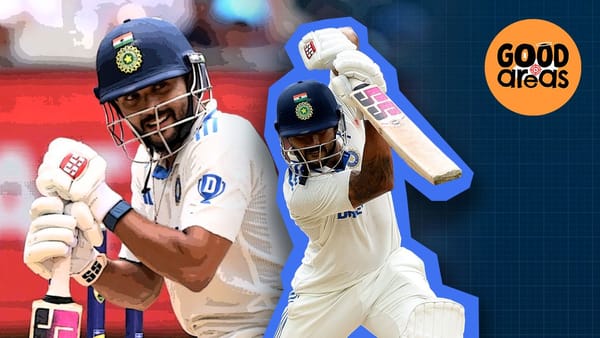Holding Mitchell Starc's hand
Some Ben Duckett too. And also something on England's effort to be dismissed by so many bouncers.
Mitchell Starc bowled Australia's first delivery in this Test, which is what usually happens. If we know anything about him, it's that.
We also know Starc is really tall, really fast, and really left-armed. That should be enough for greatness on its own in Tests. But his career arc has been far weirder than that.
Let's look at him by tools: speed, height, arm, bounce, and swing. Accuracy and high-end wrist skills are the only things he doesn't have. That suggests he should be one of the greatest bowlers ever. But nothing about Starc follows a typical path. He is one of the best bowlers of this era, but certainly nowhere near the top of the list.
There are no bowlers on this list without talent. The cluster at the front is the elites, Rabada, Steyn, Cummins, Anderson, Jadeja, Philander and Ashwin. With his tools, he could be there.

But instead, he's at the back of this second wave, next to Mohammad Shami. They spent years not taking the wickets we thought he could and bowls without helpful conditions at home.
But look how Starc moves when you take out the day/night Tests.

He moves out of that quality second cluster and ends up just near players like Shannon Gabriel, Ben Stokes and Umesh Yadav.
If you look at all the bowlers with 20 wickets or more in day-night Tests, there aren't many. But all of them except Stuart Broad are much better with the pink than red ball. That makes sense. But Lyon, Hazlewood, Anderson and Cummins have nearly identical rises.

Starc's numbers begin near Anderson and Cummins but end up near Lyon. So most of these guys get a bump from day/night cricket, but Starc's is enormous. He's marginally better than an average bowler without those pink ball wickets - which he still earned.
Many people have talked about his record against the tail, but we did an entire video on that once; it's just not true.
The day/night stuff is real, and it's not surprising he is that good with the pink ball, as many bowlers say it can act more like the white ball. Starc is incredible with that; last two World Cups, he's been the best bowler in the world, 18 wickets more than Mohammad Shami, his closest competition, at nearly half a run an over less.

Forget the World Cups; outside of a few spinners, Starc has been the best bowler in ODI since his career began.

Certainly the best seamer. Part of that is how good he is with the brand-new ball.

That reputation carries over to Tests. And obviously, he's been Australia's first-over guy. He bowls over one, three, five and seven mainly because the idea is that's when he's at his best.
He averages 26 in the first six overs.

That is fine, but he's not near the elite bowlers here. And this doesn't include his two teammates. So let's pop them in here.

Now you see the fun bit. Both Cummins and Hazlewood are better new ball bowlers than Starc. But the thought process has always been Cummins doesn't need the new ball, and Starc may not be his level with it, but he's better with it than not. That plan also allows Australia to have three bowlers forming a perfect newish ball attack.
Let's talk about the Josh Hazlewood of it all. Because in this Test, he was the one to give up the new ball. I am not really sure why that was. This was the first time since 2020 in a Test Hazlewood hasn't had the new ball, and really since 2017, it's been very rare for him in any format not to take it.

And it didn't work. Hazlewood got flogged early on his spell; as it currently stands, these are his most expensive figures, and not by a little.

They could come down in the match. But it's also worth noting that last week was his second most expensive.
If Hazlewood is a new ball bowler, then Starc has been a brand-new bowler since 2015.
That is his gig, over and over again. Sometimes he gets pushed all the way to the second bowler. But even that is rare. But I want to focus on a couple of things here.

This clump in 2022, you can see, is when Australia lost confidence in Starc and the new ball at the World Cup. Mainly because he'd stopped swinging the ball because they were trying to make him into a wobble ball bowler. But these are the more important moments for this story, 2019 and 2023. In 2019 for the Ashes, Australia used Starc's second chance; that was the last time he didn't get the new ball in a Test. The next time was the World Test Championship final at the Oval.
Both of those games are in the UK, of course. That means that both of these games were with Dukes balls. And they are obviously very different to Kookaburras or SGs. The Dukes don't swing as much early on because it's usually later when the lacquer comes off.
Instead of telling you this, let me show you through the medium of Tim Southee—another seamer who likes the new ball and swings the kookaburra everywhere. But look at his record in England with the very new ball.

Outside a weird blip in overs 40-50, his UK record is similar to that in New Zealand. But not the new ball. It really doesn't work as well for swing bowlers early; it's better for seam.
Southee is a much better swing bowler than Starc as well. Southee was probably the last proper international swing bowler until the wobble ball got him too. Starc is not really a swing bowler. He is a bowler who can swing a very new ball for a short period. That's very different. And it means you need the ball when it swings the most. In England, it's harder to work out exactly when the lacquer might come off.
The Aussies know this, and they had a lot of discussions on when to bowl him in the UK. Hence why he wasn't given the new ball in the second innings against India.

And so my first thought was simple, don't give Starc the new ball. Whether it is Boland, Hazlewood or Cummins, all of them have better skills for that. Starc is perfect for the brand-new nut outside of England, but the seam bowlers are the better option over here.
In the WTC final, he bowled two overs upfront. He started with a bouncer, the next ball was back of a length, and Rohit tucked it away; the third was the long ball that shapes back in; the fourth was the ball you want him to bowl, very full and swinging back in; he gets his line wrong again on the pads and finishes over one with a nice line that curves around the stumps a little.
Next over, it starts with a back of a length ball just outside the leg; he swings this one, but pointlessly, then a length ball here that swings a little bit, nice delivery. This ball almost seems to slip out of his fingers; well, I hope it does. Otherwise, this is a odd ball. And slightly over pitched the last one, but ok.
It isn't that these two overs are horrible. He has bowled far more that are way worse. But this does show you he's not on the spot. He is not probing, and the other thing is the ball isn't swinging much. It is curving a little, but nothing an opener should worry about.

So you can see why he might be sheltered from the new ball in England, but there is a hitch in that. Ben Duckett is another odd cricketer like Starc. And I am not even talking about the fact that Duckett averages twice as much in London playing first-class cricket than anywhere else.

But no matter the location, the best zone to bowl to Duckett is back of a length outside off. It was something undeniable when he played ODIs against South Africa. We talked about it on talkSPORT then, and so did Simon Hughes. Of course, the easy option here is to leave the ball outside off stump.

That is exactly what Duckett said to Hughes' tweet. But there is a problem here; he does not leave the ball.
When I say he doesn't leave, I mean that Duckett does not actually believe in this shot (or non-shot) compared to all normal openers in the world. The player who does this the second least in the last two years is Abdullah Shafique; he does it 17% of the time.

Duckett is 1.8%.
The one interesting thing is Australia's best hope of bowling that back of a length outside off stump was going to be Starc or Cameron Green. But because Starc was bowling early, it meant he would try to swing it. Most of his deliveries didn't go, but one went massively. When he did hit the zone against Duckett, he got one edge over slips, and another fell short. But mostly, he stayed bowling full. But he never stayed there.
That is partly because he never stays in one spot. Mitchell Starc is not a line and length bowler; he is a line-or-length bowler. That is not what's needed for England.
Starc's away record holds up pretty well. He's clearly on a different level at home, but if you took out the pink ball wickets, he's basically as good home and away.

Let's break it up by country.

You'll see India and the UAE are the only places he struggles. The West Indies and Sri Lanka cannot handle him at all. But he's done fine in England. The problem is that an average of 31 in England is not especially good.
Starc has 10 Tests in England, eight of them were before 2016. In 2013 and 15, he wasn't yet an experienced Test bowler.
The only Test he played in 2019 was at Manchester, where he lost the new ball in the second innings and made 54. People talk about his batting as another reason to be in the team, but that was his only 50 since 2017. So while he strengthens this tail, it's still not great.
What else does Starc bring to the team? You will hear a lot of his impact on Nathan Lyon's career. Commentators love talking about how left-armers help offices.

We've never found proof that having a single left-armer in your side helps off-spinners - though I see the logic.

And he brings negatives; he struggles to keep the runs slow. In the WTC final, he went at more than five runs per over in each innings. But against England in this match, he was hovering around eight for much of the day. It's weird to think an excellent white-ball cricketer would struggle. But he's a different kind of beast without the white ball.
He takes wickets, though. Only three bowlers in the world take them quicker than he does.

A wicket every 49 balls is something quite special.
And so even on the second day at Lord's, where he struggled with the ball, he still took Joe Root with a bouncer. He still takes wickets, even on gloomy days. But he needs special treatment. He is not a bowler that just fits in normally.
Today something quite weird happened after Starc got the new ball. Because of when tea came, it meant that he bowled twice with it, three overs before and then a couple after.

It was his fifth over where he got hit for runs, so they yanked him from the attack. Why does this matter, because it meant that Starc didn't bowl with the dukes ball from overs 10-25. Or, as it is known in England, the swing time.
It is counter-intuitive to think of someone who can bowl so many great balls from this height, at speed, is a southpaw, and still might need special treatment. It is why some Australian fans never quite warmed to him. He should be destroying universes, but he is actually a bit frail. I once described him as a sabre tooth tiger. But they still went extinct.
As good as Starc can be, sometimes he just needs his hand held a little. Today he was used wrong, and the new ball was not his friend.
England’s short ball short patience
The short ball doesn't work that well in English Tests. This might seem weird because we see it a lot, but in England, clearly, the best place to bowl is on a length. Last 3 years, that averages 19, while the bouncer is the next best at 32. But it's pretty much the same as back of a length.
But that includes when the ball is new, so let's only look at the ball from overs 40-80. In that, length is 24, the bouncer is 38, and the back of a length is 41. So the bouncer is ok, but still not that great.
Remember, of course, England bounces the tail a lot, so let's look at only the top seven players. Length still takes them at an average of 31, but the back of the length is next best at 42, and the bouncer is 68.
So with an old ball in England against a top-order player, you don't usually get dismissed much. What England did today was pretty special. Well, that may not be the words England fans have for it.
The ball was soft, Australia were out of plans, and they just decided to go all in on the bouncer because they thought England wouldn't stop swinging at it. And until Ben Stokes came in, they were right, and because of that, England let Australia way back into the game.




